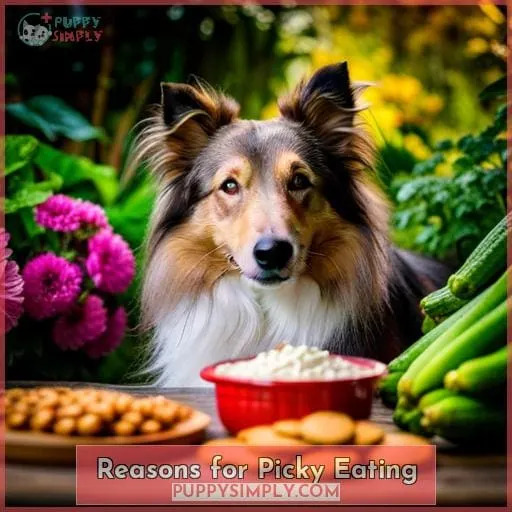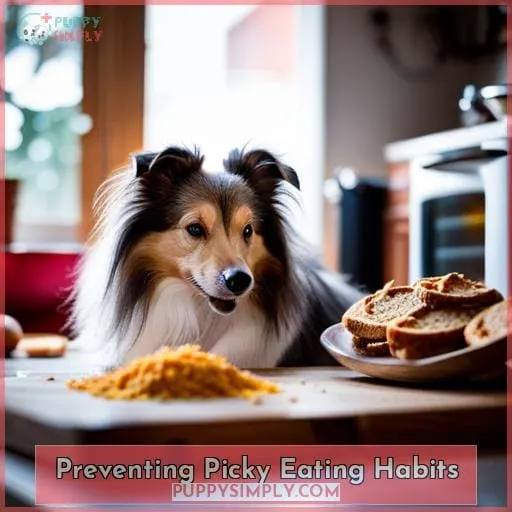This site is supported by our readers. We may earn a commission, at no cost to you, if you purchase through links.

Of course, you’ll wonder whether Fluffy’s just finicky or if there’s more to it.
Though boredom and health issues often cause fussiness, simple solutions get to the root and ensure your Sheltie fills up.
With some TLC and the right tricks tailored to your pet’s needs, you’ll have your happy eater in no time.
Table Of Contents
Key Takeaways
- Set mealtimes and routines prevent grazing and encourage regular eating habits in Shelties.
- Use puzzle toys and feeders to stimulate mental activity and increase appetite.
- Rotate between a few high-quality foods to maintain interest and nutrition.
- Check for underlying health issues if appetite changes drastically or weight loss occurs.
Are Shelties Picky Eaters?
When raising a Sheltie pup, you’ll find that some can be quite finicky about their food.
Shelties have varied palate preferences and taste sensitivities. This appetite challenge leads many Shelties to become picky eaters, tiring quickly of everyday dog food and lacking enthusiasm at mealtimes.
However, as active breeds with high metabolisms, they require consistent nutrition.
Seek culinary solutions to pique their interest such as nutritional variety, elevating their meals with healthy dog food toppers to enhance flavor.
Experiment to discover appetites triggers tailored to your Sheltie’s picky preferences.
Meeting their niche needs prevents begging for scraps while ensuring they receive proper nutrition within their lifetime, as Shelties have a relatively short lifespan.
With care and creativity, you can conquer their picky eating habits through nutritional solutions suited to their taste.
Reasons for Picky Eating
Many Sheltie owners struggle with getting their pups to consistently eat.
Health issues like food allergies or gastrointestinal problems may be to blame, but oftentimes boredom with bland kibble is the culprit behind fussy eating.
Finding ways to spice up mealtime by adding tasty mix-ins or turning eating into a game can help transform even the pickiest pup into an eager eater.
Health Concerns
You’d pick up on potential health issues if your Sheltie suddenly turns its nose up at meals it previously relished.
Underlying disease, oral pain, or gastrointestinal distress could curb your pup’s appetite and require veterinary advice.
While finicky eating might simply reflect a Sheltie’s sensitive, anxious temperament, abruptly altered dietary preferences warrant investigation into possible physical ailments before attempting training techniques or mealtime strategies.
Monitoring your dog’s eating schedule helps quickly identify concerning changes.
Boredom
Your Sheltie’s pickiness may stem from sheer boredom with their daily diet.
- Enrichment Toys
- Interactive Play
- Mental Stimulation
- Novel Treats
- Puzzle Feeders
Providing mental stimulation through games, toys, and varying their foods can help prevent boredom and encourage picky Shelties to eat.
Tips for Fussy Shelties
When your Sheltie turns up its nose at mealtime, it can be frustrating.
To get your pup eating regularly again, consider:
- Scheduling set mealtimes rather than free-feeding.
- Providing more exercise to increase its appetite.
Sticking to a routine and activity plan can help transform even the pickiest eater into an enthusiastic mealtime companion.
Schedule Meals
Sticking to consistent mealtimes prevents your Sheltie from grazing and teaches them to eat when food is offered.
Establishing a timely feeding routine with properly portioned meals planned at regular intervals throughout the day.
The picky eating habits of Shelties can be managed by ensuring they receive scheduled nutrition on a dietary schedule rather than relying on sporadic snacks.
Exercise More
Getting more exercise is another tip for dealing with your Sheltie.
Consider providing:
- Interactive toys
- Outdoor activities like running and playing fetch
- Training games that provide mental stimulation
Puzzle feeders can make your intelligent, herding velcro dog work for food.
Shelties need lots of exercise to prevent boredom that contributes to picky eating habits.
Getting Picky Shelties to Eat
If your Sheltie turns up their nose at their normal kibble, don’t panic.
There are tasty toppers and mealtime strategies to entice even the fussiest fur baby.
Sprinkle on some freeze-dried raw, a nutrient boost loaded with flavor.
Hand feed for close bonding.
Or, get their tail wagging with a food puzzle st■ with kibble and treats.
These culinary enrichments make chow time as mentally stimulating as playtime.
If barking for table scraps, resist overindulging.
Stick to scheduled feedings with measured portions to prevent bad habits.
With patience and creative solutions, you can get your picky pup lapping up their bowl again.
When to Worry About Picky Eating
Although picky eating is common in Shelties, you’d be wise to consult your vet if your pup loses significant weight or goes more than a day without eating.
As pack animals, Shelties thrive on predictable feeding schedules, so drastic changes in appetite likely indicate an underlying issue.
Look for potential behavioral triggers like a stressful event that disrupted their routine.
Also, get them a health check to rule out illness.
Trying different healthy foods may help, since variety keeps some picky pups interested.
But if picky eating leads to rapid weight loss or skipping multiple meals altogether, don’t hesitate to consult your vet for tailored advice.
They can assess your Sheltie’s condition and provide guidance to get their diet back on track.
With some dietary adjustments catered to your pup, their appetite should bounce back.
Preventing Picky Eating Habits
Your Sheltie’s picky eating habits can be prevented by:
- Establishing a consistent feeding routine:
- Set mealtimes and stick to them.
- Using puzzle feeders:
- Use interactive toys and puzzle feeders at mealtime.
- Avoiding unhealthy table scraps:
- Rotate between 2-3 high-quality dog foods.
- Use treats primarily for training rewards.
By feeding your Sheltie at the same times each day, providing mental stimulation through interactive feeders, offering nutritional variety, and limiting human food, you can help prevent the development of picky eating habits.
Establishing healthy eating habits from the start with your Sheltie pup is key.
Frequently Asked Questions (FAQs)
What human foods can I safely feed my sheltie?
Offer your sheltie small amounts of:
- Plain cooked chicken
- Beef
- Turkey
- Sweet potatoes
- Apples
- Carrots
- Green beans
- Oatmeal
Avoid:
- Onions
- Garlic
- Grapes
- Raisins
- Chocolate
- Fatty meats
These foods can harm them.
How much exercise does my sheltie need per day?
Take your sheltie on at least 30-60 minutes of vigorous exercise daily to meet their high activity needs.
This energetic dog thrives on:
- Walks
- Runs
- Playtime
- Training
Providing enough exercise will help avoid problem behaviors in your smart sheltie.
Are shelties prone to separation anxiety?
Yes, Shelties are prone to separation anxiety.
Provide them with mental stimulation and exercise before leaving them alone.
Ease them into longer periods of separation gradually to help prevent anxiety.
Leaving a radio on and their favorite toys can provide comfort too.
How often should I groom my sheltie’s coat?
Brush your sheltie’s coat thoroughly once a week to remove loose hair and prevent matting.
Daily brushing keeps their luxurious double coat looking its best.
Establish a consistent grooming routine for their health and happiness.
How can I best socialize my sheltie puppy?
Introduce your sheltie puppy to many people, places, and other dogs in a calm, positive way.
Reward good behavior.
Keep sessions brief and end on a high note to build confidence.
With consistent, gentle socialization, she’ll grow into a friendly, well-adjusted adult.
Conclusion
Like a fussy toddler at the dinner table, your Sheltie’s picky eating habits can drive you barking mad.
But just as patience and creativity tame the choosy child, simple solutions tailored to your pup’s needs can turn their nose up at kibble into chow down excitement.
With an observant eye to spot potential problems, a proactive approach to address the underlying cause, and some playful inventiveness at mealtime, you can show your finicky Sheltie that good food is worth sitting up and begging for.












